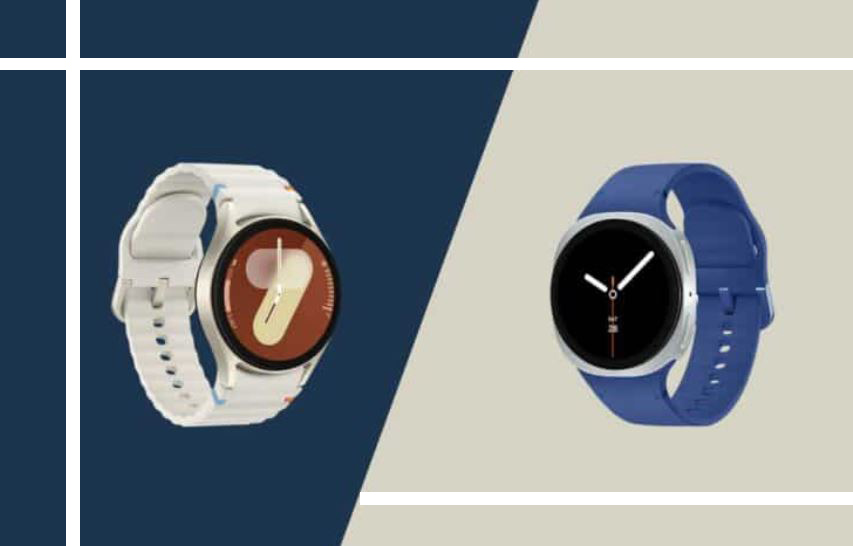
Samsung’s Galaxy Watch series continues to dominate the smartwatch market, with the Galaxy Watch 8 and Galaxy Watch 7 representing the latest iterations of this popular wearable line. While these watches share many similarities, several important distinctions set them apart. This comprehensive comparison will explore all the key differences to help you determine which model better suits your needs.Galaxy Watch 8 vs 7
Design and Build Quality
The first noticeable difference between these two models lies in their physical appearance and construction. The Galaxy Watch 8 introduces a slightly refined design language that builds upon the successful formula of its predecessor while incorporating subtle improvements.Galaxy Watch 8 vs 7
The Watch 8 features a more streamlined case with smoother edges, making it more comfortable for all-day wear. Samsung has reduced the thickness by approximately 0.5mm compared to the Watch 7, which might not sound significant but contributes to a noticeably sleeker profile on the wrist. Both models maintain the rotating bezel functionality that Samsung users love, though the Watch 8’s bezel operates with even smoother mechanics.
Materials have seen an upgrade in the newer model. While both watches use aluminum for their standard versions, the Galaxy Watch 8 offers a titanium option even in the smaller sizes, whereas the Watch 7 reserved titanium only for its larger Classic edition. This makes premium materials more accessible across the entire Watch 8 lineup.Galaxy Watch 8 vs 7
Color options differ between the two generations. The Watch 7 came in more conservative tones like black, silver, and gold, while the Watch 8 expands the palette with bolder choices including navy blue and green options that better match Samsung’s latest smartphone colors.
Display Technology
Screen technology represents another area where the Galaxy Watch 8 shows measurable improvement over its predecessor. Both models feature Samsung’s excellent Super AMOLED displays with always-on functionality, but the Watch 8 pushes brightness capabilities further.
The Galaxy Watch 8 can reach up to 2,000 nits of peak brightness, a significant jump from the 1,500 nits maximum of the Watch 7. This enhanced brightness makes the newer watch much more readable in direct sunlight – a crucial improvement for outdoor enthusiasts. The display also features improved power efficiency, contributing to better battery life despite the increased brightness potential.
Resolution remains identical between the two models, with the 40mm/42mm versions offering 396 x 396 pixels and the 44mm/46mm variants providing 450 x 450 pixels. However, the Watch 8 introduces a new anti-reflective coating that reduces glare in various lighting conditions.Galaxy Watch 8 vs 7
Performance and Hardware
Under the hood, the Galaxy Watch 8 debuts Samsung’s new in-house W980 chipset, replacing the W920 found in the Watch 7. This new processor delivers approximately 20% better performance while being 15% more energy efficient. Real-world usage shows noticeably snappier app launches and smoother animations on the Watch 8.
Both watches include 1.5GB of RAM, but the Watch 8 benefits from faster LPDDR5 memory compared to the LPDDR4X in the Watch 7. Storage options remain the same at 16GB across all models, providing ample space for apps, music, and other data.
Connectivity sees minor improvements in the newer model. While both support Bluetooth 5.2, the Watch 8 enhances Wi-Fi capabilities with support for the 6GHz band where available. GPS accuracy has also been improved in the Watch 8, with faster satellite acquisition times and better performance in urban environments with tall buildings.Galaxy Watch 8 vs 7
Health and Fitness Features
Health monitoring represents one of the most significant areas of improvement in the Galaxy Watch 8. While both watches include standard sensors like optical heart rate monitors, ECG, and blood oxygen tracking, the Watch 8 introduces several advanced health capabilities.
The most notable addition is the blood glucose monitoring feature, which uses non-invasive optical sensors to estimate blood sugar levels. While not as accurate as finger-prick tests, this functionality provides valuable trends for health-conscious users and those monitoring pre-diabetic conditions.
Sleep tracking has been enhanced in the Watch 8 with the ability to detect more sleep disturbances and provide more detailed sleep stage analysis. The watch can now recognize signs of sleep apnea (though it cannot diagnose the condition) and suggest when users might want to consult a healthcare professional.
Both watches include body composition measurement, but the Watch 8 provides more detailed metrics including visceral fat level tracking and improved muscle mass measurement accuracy. The newer model also adds hydration reminders based on activity levels and environmental conditions.
For athletes, the Watch 8 introduces several new workout modes including pickleball and padel tennis recognition. It also offers improved automatic workout detection with fewer false positives than the Watch 7. Recovery metrics have been enhanced with more detailed recommendations for rest periods between intense training sessions.
Battery Life and Charging
Battery performance shows modest but meaningful improvements in the Galaxy Watch 8. Despite having similarly sized batteries (300mAh for the small model, 425mAh for the large), the Watch 8 delivers approximately 10% longer runtime thanks to its more efficient processor and display.
In real-world testing, the Galaxy Watch 8 typically lasts about 40 hours with always-on display enabled, compared to 36 hours for the Watch 7 under the same conditions. With always-off display, both can stretch to about two days, but the Watch 8 consistently reaches the 48-hour mark more reliably.
Charging speeds remain identical between the two models, with both supporting 10W fast charging. A full charge takes about 90 minutes for either watch. The Watch 8 does introduce a new battery health monitoring feature that provides more detailed information about charging patterns and long-term battery degradation.
Software and Features
Both watches run Samsung’s Wear OS with One UI Watch interface, but the Watch 8 launches with a newer version that includes several exclusive features. The most notable is the enhanced Bixby assistant that can now handle more complex commands and perform some on-device processing without requiring an internet connection.
The Watch 8 introduces new watch faces that take better advantage of the improved display capabilities, including some that show more health data at a glance. It also includes additional customization options for complications and color schemes.
Smart home control has been enhanced in the Watch 8, with support for Matter devices and improved integration with Samsung SmartThings. The newer watch can also function as a digital key for certain car models and hotel room doors when paired with a compatible smartphone.
Price and Value Proposition
Pricing remains similar between the two generations at launch, with the Galaxy Watch 8 carrying a modest $20-$30 premium over the Watch 7’s original MSRP depending on size and configuration. However, with the Watch 7 now being the previous-generation model, it’s frequently available at significant discounts that make it an attractive value proposition.
The Galaxy Watch 8 justifies its higher price with meaningful improvements in health tracking, display quality, and performance. For users who value the latest health monitoring features or need maximum outdoor visibility, the newer model is clearly the better choice. However, budget-conscious buyers who can live without the cutting-edge health sensors might find the discounted Watch 7 offers better value.
Which One Should You Choose?
Your decision between the Galaxy Watch 8 and Watch 7 ultimately depends on your priorities and budget. The Watch 8 represents the clear technological leader with its advanced health sensors, brighter display, and improved performance. It’s the better choice for:
- Users who want the latest health monitoring features
- Outdoor enthusiasts who need maximum screen visibility
- Tech early adopters who want the newest technology
- Those who value premium materials in smaller watch sizes
On the other hand, the Galaxy Watch 7 remains a capable smartwatch that delivers excellent performance at a reduced price. It’s ideal for:
- Budget-conscious buyers
- Users who don’t need advanced health tracking
- Those upgrading from older Galaxy Watch models
- People who prefer more conservative color options
Both watches represent excellent choices in the Android smartwatch market, continuing Samsung’s tradition of combining stylish design with robust functionality. The Galaxy Watch 8 moves the series forward with meaningful improvements, while the Watch 7 remains a compelling option at its now-reduced price point.

[…] Apple is reportedly preparing to disrupt the laptop market with an affordable MacBook powered by the same chipset as the upcoming iPhone 16 Pro. This move could redefine budget-friendly computing while maintaining Apple’s signature performance and efficiency.Apple’s Budget MacBook Coming Soon […]